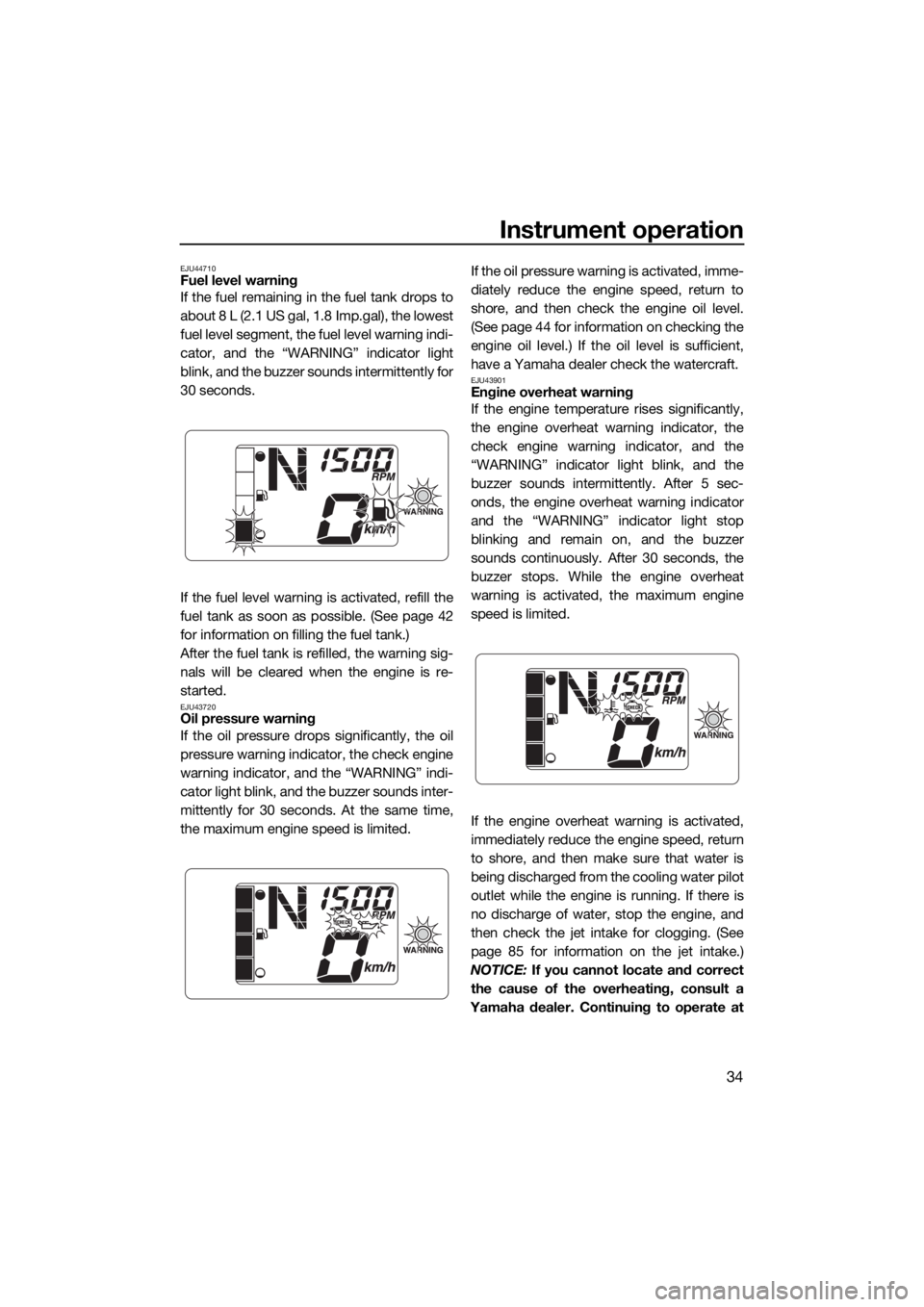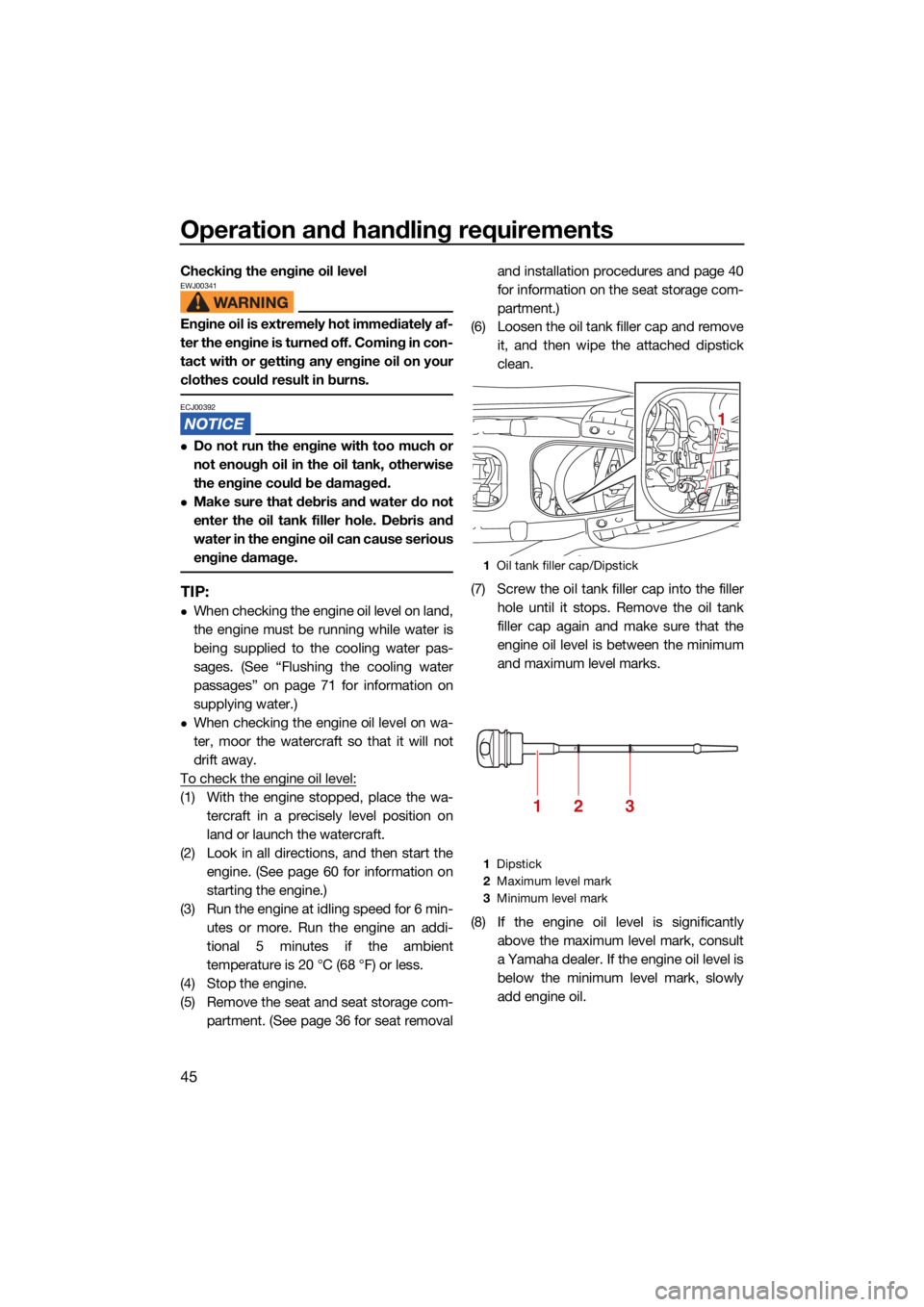stop start YAMAHA EXR 2021 Owners Manual
[x] Cancel search | Manufacturer: YAMAHA, Model Year: 2021, Model line: EXR, Model: YAMAHA EXR 2021Pages: 98, PDF Size: 4.56 MB
Page 6 of 98

Table of contents
General and important labels ........... 1Identification numbers .................... 1
Primary Identification (PRI-ID)
number............................................ 1
Craft Identification Number (CIN) ....... 1
Engine serial number.......................... 1
Manufactured date label .................... 2
Model information ........................... 2
Builder’s plate .................................... 2
Important labels .............................. 4
Warning labels.................................... 5
Other labels ........................................ 8
Safety information ............................. 9 Limitations on who may operate the watercraft ............................... 9
Cruising limitations ........................ 10
Operation requirements ................ 11
Recommended equipment ........... 13
Hazard information........................ 14
Watercraft characteristics ............. 14
Wakeboarding and water-skiing ... 16
Safe boating rules ......................... 17
Enjoy your watercraft responsibly ................................. 18
Description....................................... 19 Watercraft glossary ....................... 19
Location of main components ...... 20
Control function operation ............. 24 Watercraft control functions ......... 24
Engine stop switch .......................... 24
Engine shut-off switch .................... 24
Start switch ..................................... 24
Throttle lever .................................... 25
RiDE lever ........................................ 25
Steering system ............................... 25
Cooling water pilot outlet ................. 26
Water separator................................ 26
Watercraft operation ...................... 28Watercraft operation functions ..... 28
Shift system ..................................... 28
Instrument operation ...................... 31Multifunction information center ... 31
Information display ........................... 31
Equipment operation ...................... 36Equipment..................................... 36
Seat .................................................. 36
Handgrip........................................... 36
Reboarding grip................................ 37
Reboarding step ............................... 37
Bow eye............................................ 38
Stern eyes ........................................ 38
Cleat ................................................. 38
Storage compartments .................... 38
Fire extinguisher holder .................... 41
Operation and handling
requirements ................................... 42Fuel requirements ......................... 42
Fuel................................................... 42
Engine oil requirements ................ 44
Engine oil .......................................... 44
Draining the bilge water ................ 46
Draining the bilge water on land....... 46
Draining the bilge water on water .... 47
Transporting on a trailer................ 48
First-time operation ........................ 49 Engine break-in............................. 49
Pre-operation checks ..................... 50
Pre-operation checklist .................... 50
Pre-operation check points .......... 52
Pre-launch checks ........................... 52
Post-launch checks.......................... 57
Operation ......................................... 59 Operating your watercraft ............. 59
Getting to know your watercraft....... 59
UF4L72E0.book Page 1 Thursday, June 18, 2020 1:29 PM
Page 7 of 98

Table of contents
Learning to operate your watercraft ...................................... 59
Riding position ................................. 60
Launching the watercraft ................. 60
Starting the engine on water ............ 60
Stopping the engine ......................... 61
Leaving the watercraft...................... 61
Operating the watercraft .................. 61
Turning the watercraft ...................... 62
Stopping the watercraft ................... 63
Operating the watercraft in reverse or neutral ...................................... 64
Boarding the watercraft ................... 65
Starting off........................................ 67
Capsized watercraft ......................... 68
Beaching and docking the watercraft ...................................... 69
Operating in weeded areas .............. 69
After removing the watercraft from the water ....................................... 70
Care and storage............................. 71Post-operation care ...................... 71
Flushing the cooling water
passages....................................... 71
Cleaning the watercraft .................... 72
Battery care ...................................... 72
Long-term storage ........................ 74
Cleaning ........................................... 74
Lubrication ....................................... 74
Rustproofing..................................... 75
Maintenance .................................... 77 Maintenance.................................. 77
Periodic maintenance chart ............. 78
Engine oil and oil filter ...................... 80
Specifications .................................. 81Specifications................................ 81
Trouble recovery ............................. 82 Troubleshooting ............................ 82
Troubleshooting chart ...................... 82
Emergency procedures ................ 85
Cleaning the jet intake and
impeller ......................................... 85
Raising the reverse gate .................. 86
Jumping the battery ......................... 86
Towing the watercraft....................... 87
Submerged watercraft ..................... 87
Index................................................. 89
UF4L72E0.book Page 2 Thursday, June 18, 2020 1:29 PM
Page 29 of 98

Description
22
1210 9
36
4
7
8
4
5
1
RiDE lever (page 28)
2 Start switch (page 24)
3 Engine shut-off switch (page 24)
4 Rearview mirror
5 Clip (page 24)
6 Throttle lever (page 25)
7 Multifunction information center (page 31)
8 Glove compartment (page 39)
9 Engine shut-off cord (lanyard) (page 24)
10 Engine stop switch (page 24)
UF4L72E0.book Page 22 Thursday, June 18, 2020 1:29 PM
Page 31 of 98

Control function operation
24
EJU31026
Watercraft control functionsEJU31153Engine stop switch “ ”
The engine stop switch (red button) stops the
engine when the switch is pushed.
EJU31164Engine shut-off switch “ ”
The engine shut-off switch automatically
stops the engine when the clip, on the end of
the engine shut-off cord (lanyard), is removed
from the switch, such as if the operator falls
off the watercraft.
Insert the clip under the engine shut-off
switch before starting the engine.
When the engine is not running, remove the
clip from the engine shut-off switch to pre-vent accidental starting or unauthorized op-
eration by children or others.
EJU44350Start switch “ ”ECJ01311
Do not run the engine over 4000 r/min on
land. Also, do not run the engine for more
than 15 seconds without supplying water,
otherwise the engine could overheat.
The start switch (green button) starts the en-
gine when the switch is pushed.
Release the start switch as soon as the en-
gine starts to run. If the engine does not start
in 5 seconds, release the start switch, wait 15
seconds, and then try again.
NOTICE: Never
push the start switch while the engine is
running. Do not operate the start switch
for more than 5 seconds, otherwise the
battery will be discharged and the engine
1 Engine stop switch
1 Engine shut-off switch
2 Clip
3 Engine shut-off cord (lanyard)
1
1
2
3
UF4L72E0.book Page 24 Thursday, June 18, 2020 1:29 PM
Page 32 of 98
![YAMAHA EXR 2021 Owners Manual Control function operation
25
will not start. Also, the starter motor could
be damaged.
[ECJ01041]
The engine will not start under any of the fol-
lowing conditions:
Clip is removed from the engin YAMAHA EXR 2021 Owners Manual Control function operation
25
will not start. Also, the starter motor could
be damaged.
[ECJ01041]
The engine will not start under any of the fol-
lowing conditions:
Clip is removed from the engin](/img/51/49493/w960_49493-31.png)
Control function operation
25
will not start. Also, the starter motor could
be damaged.
[ECJ01041]
The engine will not start under any of the fol-
lowing conditions:
Clip is removed from the engine shut-off
switch.
Throttle lever is squeezed.
Throttle lever is malfunctioning.
RiDE lever is squeezed.
RiDE lever is malfunctioning.EJU31212Throttle lever
The throttle lever increases the engine speed
when the lever is squeezed.
The throttle lever returns automatically to its
fully closed (idle) position when released.
EJU43342RiDE lever
When the RiDE lever is squeezed, the reverse
gate lowers and the watercraft starts movingin reverse. If the watercraft is moving forward,
the watercraft gradually slows down until it
stops, and then the watercraft starts moving
in reverse.
When the RiDE lever is released, it automati-
cally returns to its fully closed (idle) position
and the reverse gate moves to the neutral po-
sition.
EJU31262Steering system
By turning the handlebars in the direction you
wish to travel, the angle of the jet thrust noz-
1
Start switch
1 Throttle lever
1
1
1RiDE lever
1
UF4L72E0.book Page 25 Thursday, June 18, 2020 1:29 PM
Page 33 of 98

Control function operation
26
zle is changed, and the direction of the water-
craft is changed accordingly.
Since the strength of the jet thrust determines
the speed and degree of a turn, throttle must
always be applied when attempting a turn,
except at trolling speed.
This model is equipped with the Yamaha En-
gine Management System (YEMS) that in-
cludes an off-throttle steering (OTS) system.
It will activate at planing speeds should you
attempt to steer the watercraft after releasing
the throttle lever. The OTS system assists in
turning by continuing to supply some thrust
while the watercraft is decelerating, but you
can turn more sharply if you apply throttle
while turning the handlebars. The OTS sys-
tem does not function below planing speeds
or when the engine is off. Once the engine
slows down, the watercraft will no longer turn
in response to handlebar input until you apply
throttle again or you reach trolling speed.EJU35975Cooling water pilot outlet
When the engine is running, some of the
cooling water that is circulated in the engine
is discharged from the cooling water pilot
outlet.
There is a cooling water pilot outlet on the
port (left) side of the watercraft. To check for
proper operation of the cooling system, make
sure that water is being discharged from the
cooling water pilot outlet. If water is not being
discharged from the outlet, stop the engine
and check the jet intake for clogging. (See
page 85 for information on the jet intake.)
TIP:
It will take about 60 seconds for the water
to reach the outlet after the engine is start-
ed.
Water discharge may not be constant
when the engine is running at idling speed.
If this occurs, apply a little throttle to make
sure that water discharges properly.
EJU40323Water separator
The water separator prevents water from en-
tering the fuel tank by collecting any water
that has entered the fuel tank breather hose if
the watercraft was capsized.
1Handlebar
2 Jet thrust nozzle
1
21Cooling water pilot outlet
1
UF4L72E0.book Page 26 Thursday, June 18, 2020 1:29 PM
Page 38 of 98

Instrument operation
31
EJU44570
Multifunction information center
The multifunction information center displays
various watercraft information.
Multifunction information center initial op-
eration
When the multifunction information center is
activated, all of the display segments come
on. After 2 seconds, the warning indicators in
the information display go off, and then the
center starts to operate normally.
Multifunction information center standby
state
If the multifunction information center does
not receive any operation input within 30 sec-
onds after the engine stops, the center will
turn off and enter a standby state. When the
engine is started again, the displays return to
their state before the center turned off, and
then the center starts to operate normally.
EJU35027Information display
The information display shows watercraft op-
erating conditions.
EJU43832Speedometer
The speedometer shows the watercraft
speed against water.
By switching the display units, the speed can
be shown in kilometers per hour “km/h” or
miles per hour “MPH”.
TIP:
“MPH” is selected as the display unit at the
Yamaha factory.
1 Information display
2 “WARNING” indicator light
12
1Fuel level meter
2 Shift indicator
3 Engine overheat warning indicator
4 Check engine warning indicator
5 Tachometer / hour meter / voltmeter
6 Oil pressure warning indicator
7 Fuel level warning indicator
8 Speedometer
1 Speedometer
251346
78
1
UF4L72E0.book Page 31 Thursday, June 18, 2020 1:29 PM
Page 39 of 98

Instrument operation
32
To switch the speedometer display units:
Start the engine, stop the engine, and then
push the engine stop switch 3 times, pushing
the switch for 0.4 seconds or more each time,
before the multifunction information center
turns off. The speedometer display units
change.
To switch the speedometer display units
again, repeat this procedure.
EJU44650Tachometer
The tachometer shows the engine speed.
TIP:
While the engine is stopped, the battery volt-
age and the total engine hours are displayed
alternately.
EJU43891Shift indicator
This indicator shows the reverse gate shift
positions: “F” (forward), “N” (neutral), and “R”
(reverse). (See page 28 for shifting proce-
dures.)
EJU44700Hour meter and voltmeter
The hour meter and voltmeter are displayed
in the tachometer portion of the information
display while the engine is stopped.
1 Engine stop switch
1 Speedometer
1
1
1Tachometer
1 Shift indicator
2 “F” (Forward position)
3 “N” (Neutral position)
4 “R” (Reverse position)
1
12
3
4
UF4L72E0.book Page 32 Thursday, June 18, 2020 1:29 PM
Page 41 of 98

Instrument operation
34
EJU44710Fuel level warning
If the fuel remaining in the fuel tank drops to
about 8 L (2.1 US gal, 1.8 Imp.gal), the lowest
fuel level segment, the fuel level warning indi-
cator, and the “WARNING” indicator light
blink, and the buzzer sounds intermittently for
30 seconds.
If the fuel level warning is activated, refill the
fuel tank as soon as possible. (See page 42
for information on filling the fuel tank.)
After the fuel tank is refilled, the warning sig-
nals will be cleared when the engine is re-
started.
EJU43720Oil pressure warning
If the oil pressure drops significantly, the oil
pressure warning indicator, the check engine
warning indicator, and the “WARNING” indi-
cator light blink, and the buzzer sounds inter-
mittently for 30 seconds. At the same time,
the maximum engine speed is limited.If the oil pressure warning is activated, imme-
diately reduce the engine speed, return to
shore, and then check the engine oil level.
(See page 44 for information on checking the
engine oil level.) If the oil level is sufficient,
have a Yamaha dealer check the watercraft.
EJU43901Engine overheat warning
If the engine temperature rises significantly,
the engine overheat warning indicator, the
check engine warning indicator, and the
“WARNING” indicator light blink, and the
buzzer sounds intermittently. After 5 sec-
onds, the engine overheat warning indicator
and the “WARNING” indicator light stop
blinking and remain on, and the buzzer
sounds continuously. After 30 seconds, the
buzzer stops. While the engine overheat
warning is activated, the maximum engine
speed is limited.
If the engine overheat warning is activated,
immediately reduce the engine speed, return
to shore, and then make sure that water is
being discharged from the cooling water pilot
outlet while the engine is running. If there is
no discharge of water, stop the engine, and
then check the jet intake for clogging. (See
page 85 for information on the jet intake.)
NOTICE: If you cannot locate and correct
the cause of the overheating, consult a
Yamaha dealer. Continuing to operate at
UF4L72E0.book Page 34 Thursday, June 18, 2020 1:29 PM
Page 52 of 98

Operation and handling requirements
45
Checking the engine oil levelEWJ00341
Engine oil is extremely hot immediately af-
ter the engine is turned off. Coming in con-
tact with or getting any engine oil on your
clothes could result in burns.
ECJ00392
Do not run the engine with too much or
not enough oil in the oil tank, otherwise
the engine could be damaged.
Make sure that debris and water do not
enter the oil tank filler hole. Debris and
water in the engine oil can cause serious
engine damage.
TIP:
When checking the engine oil level on land,
the engine must be running while water is
being supplied to the cooling water pas-
sages. (See “Flushing the cooling water
passages” on page 71 for information on
supplying water.)
When checking the engine oil level on wa-
ter, moor the watercraft so that it will not
drift away.
To check the engine oil level:
(1) With the engine stopped, place the wa- tercraft in a precisely level position on
land or launch the watercraft.
(2) Look in all directions, and then start the engine. (See page 60 for information on
starting the engine.)
(3) Run the engine at idling speed for 6 min- utes or more. Run the engine an addi-
tional 5 minutes if the ambient
temperature is 20 °C (68 °F) or less.
(4) Stop the engine.
(5) Remove the seat and seat storage com- partment. (See page 36 for seat removal and installation procedures and page 40
for information on the seat storage com-
partment.)
(6) Loosen the oil tank filler cap and remove it, and then wipe the attached dipstick
clean.
(7) Screw the oil tank filler cap into the filler hole until it stops. Remove the oil tank
filler cap again and make sure that the
engine oil level is between the minimum
and maximum level marks.
(8) If the engine oil level is significantly above the maximum level mark, consult
a Yamaha dealer. If the engine oil level is
below the minimum level mark, slowly
add engine oil.
1Oil tank filler cap/Dipstick
1 Dipstick
2 Maximum level mark
3 Minimum level mark
1
213
UF4L72E0.book Page 45 Thursday, June 18, 2020 1:29 PM